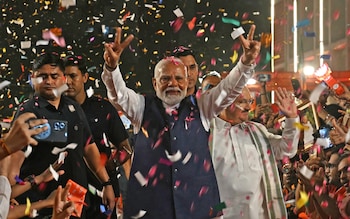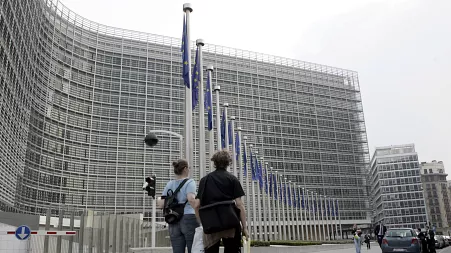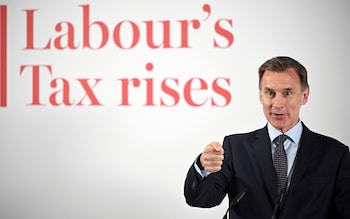After securing a surprisingly narrow victory during India’s latest elections on Wednesday, a flood of congratulations rushed in for Narendra Modi.
From Rishi Sunak to Emmanuel Macron, world leaders queued up to congratulate the Indian prime minister on his historic third term.
Yet it was Modi’s exchange with one overseas counterpart that raised eyebrows in diplomatic circles.
“My sincere congratulations to Prime Minister [Modi] on his election victory,” wrote Taiwanese president Lai Ching-te on social media platform X.
“We look forward to enhancing the fast-growing Taiwan-India partnership.”
Replying to the post, Modi said: “Thank you for your warm message. I look forward to closer ties as we work towards mutually beneficial economic and technological partnership.”
The Indian leader’s statement – though seemingly dull at first glance – will be seen as a subtle dig at China, at a time when relations between New Delhi and Beijing are decidedly frosty.
China’s communist government regards Taiwan as a rogue province that must reunify with the mainland, furiously objecting whenever foreign countries engage with the democratic island independently.
Modi, who has been India’s prime minister since 2014, certainly understands this.
“He’s a seasoned politician,” says Gray Sergeant, an Indo-Pacific expert at the London-based Council on Geostrategy. “So there’s no doubt he would have known what he was doing here.
“It shows he is not prepared to mend the relationship on Beijing’s terms alone, or step on what is, for China, a very red line.”
Unsurprisingly, the statement triggered a swift rebuttal from China.
“India has made serious political commitments regarding the one-China principle and should be vigilant against the political schemes of the Taiwan authorities and refrain from actions that violate the one-China principle,” Mao Ning, a spokesman for the Chinese Foreign Ministry told reporters on Thursday.
“There is only one China in the world.”
Relations between China and India hit a low in 2020 following violent clashes between troops from both countries along their shared 2,100-mile border in the Himalayas.
Today, around 60,000 troops from each side remain stationed along the disputed area, turning it into an effective powder keg.

However, New Delhi is also growing increasingly wary about its neighbour’s activities across the broader Indo-Pacific region, where Beijing is building up its military presence.
The two powers have both been on manoeuvres, with India recently opening its own military facility near the Maldives amid fears China is seeking bases in nearby Sri Lanka and Pakistan.
Meanwhile, Chinese president President Xi Jinping has sought to thwart India’s ambitions to play a bigger role on the global stage.
Beijing vetoed its neighbour’s bid to join the Nuclear Suppliers Group in 2016, blocked New Delhi’s efforts to put Pakistan-based terrorists on global watchlists and has repeatedly denied its attempt to join the powerful United Nations Security Council.
That is despite support from all other sitting members, including Russia.
Against that backdrop, India has sought to foster closer alliances with partners, including the US, Australia and Japan, all of which sit on the “Quad” security alliance, to help contain Chinese aggression.
However, with Modi having suffered a surprise loss of his parliamentary majority in the latest Indian elections – forcing him to rely on coalition partners – his latest position on Taiwan may be a sign of strength regarding his foreign policy.
“Symbolically, it shows efforts to send a signal to Beijing that despite the Modi government’s weakened mandate, India will maintain its more assertive and muscular foreign policy and not kowtow to pressure from China on the border,” says Dr Chietigj Bajpaee, a senior research fellow for South Asia at the Chatham House foreign policy think tank.

“More broadly, New Delhi is trying to show that it has means of counterbalancing Chinese encroachments into India’s self-perceived sphere of influence in South Asia by deepening engagement with Taiwan.”
India’s ties with Taiwan are not just for show, however.
New Delhi has no formal diplomatic ties to the self-governing island but has sought a deeper economic partnership with Taipei since the 1990s.
This has involved courting investment from Taiwan and more recently striking agreements that allow greater numbers of Indian migrants to go there to work.
Around $3.4bn (£2.66bn) of goods were exported by Taiwan to India in 2022, including $937m of integrated circuits, with other top exports including plastics and computer and office equipment.
However, the jewel in Taiwan’s economic crown remains its unparalleled ability to craft semiconductors, also known as microchips – a technology India is increasingly keen to gain a foothold in.
While the Modi government has carefully guarded against Chinese involvement in sensitive technology areas, it has sought to woo Taiwanese firms, including by rolling out a $10bn scheme to incentivise domestic manufacturing.
“The Indians are very concerned about any potential points of leverage that China could have over them,” says Sergeant. “And like a lot of other countries, they’d like a slice of the Taiwanese semiconductor pie.”
India has enjoyed only limited success with chips so far, with Taiwanese firm Powerchip teaming up with Mumbai’s Tata to establish India’s first leading-edge microchip factory (capable of making 12-inch silicon wafers).
To unlock more investment from Taiwanese chip companies, Taipei has argued a free-trade agreement is needed.
That would demonstrate an attempt to stand up to Beijing, while also improving India’s industrial capabilities.
“Substantively, a key objective of the Modi government is to develop India into a global manufacturing hub, particularly in the area of critical and emerging technologies including semiconductors,” explains Chatham House’s Bajpaee.
“Closer alignment with Taiwan is key to achieving this objective: hence, the tweet from Modi that he looks forward to a closer ‘economic and technology partnership’.
“India is eager to attract further Taiwanese investment and technology transfers.”
Modi’s social media post on Wednesday may well have been the latest example of a foreign leader pushing back against Chinese efforts to isolate Taiwan, by challenging Beijing in a subtle manner.
For example, Lord Cameron, the UK Foreign Secretary, was recently among the world leaders to congratulate Taiwan’s president for an election victory, albeit without mentioning his title.
“That is partly a response to China’s own ‘grey zone’ tactics, which seek to break the will of the Taiwanese people and force them to surrender their sovereignty without a fight,” says Sergeant at the Council on Geostrategy.
“So all these little actions are meant to push back a bit and help.”
So even with a weakened mandate, it seems Modi is keen to show how India will join the West in refusing to kowtow to China.
Disclaimer: The copyright of this article belongs to the original author. Reposting this article is solely for the purpose of information dissemination and does not constitute any investment advice. If there is any infringement, please contact us immediately. We will make corrections or deletions as necessary. Thank you.



